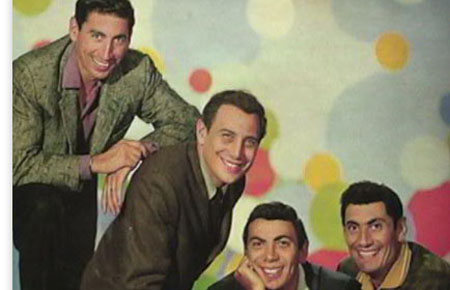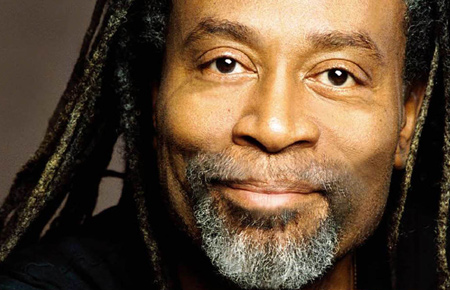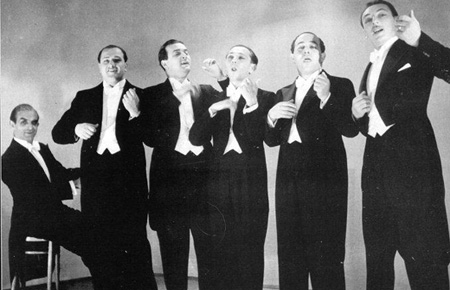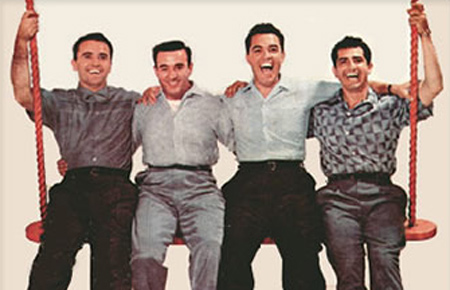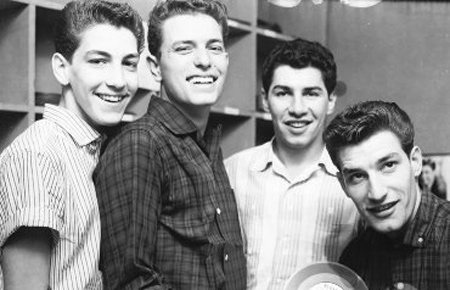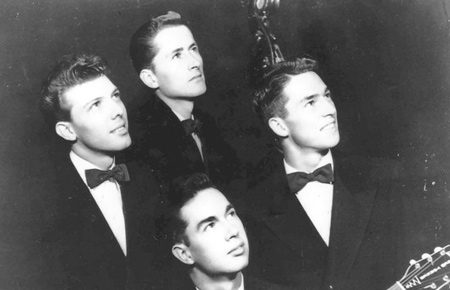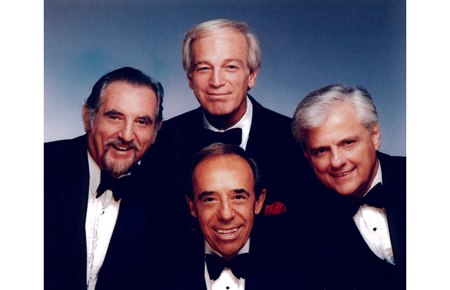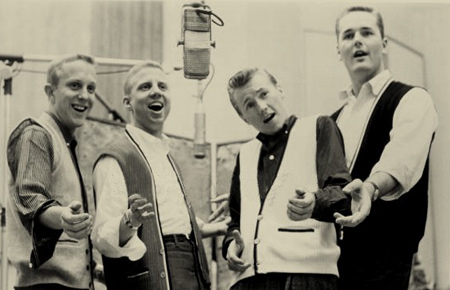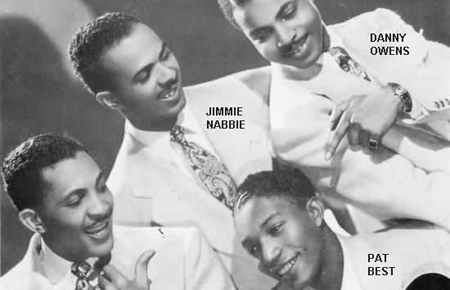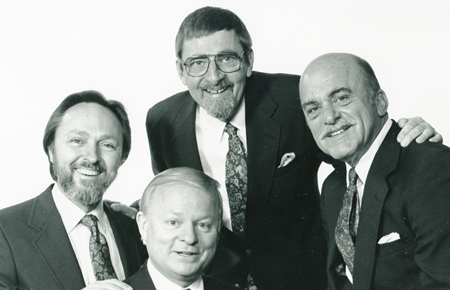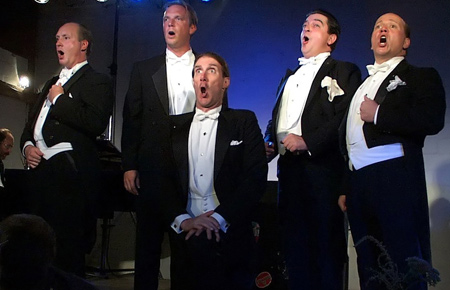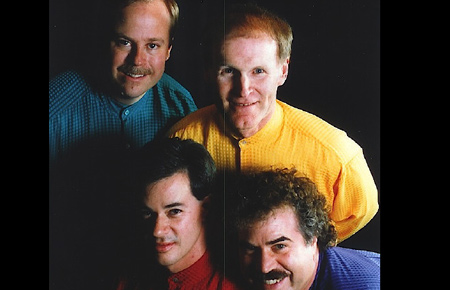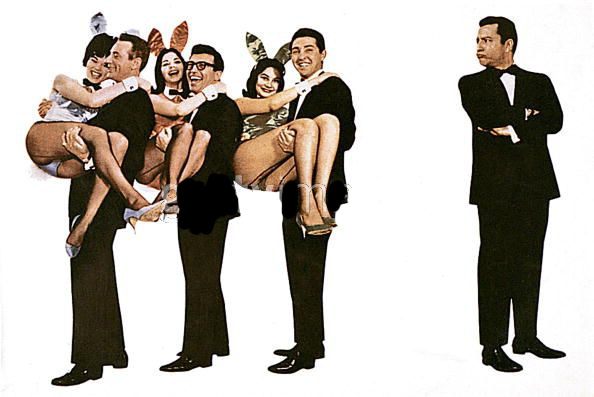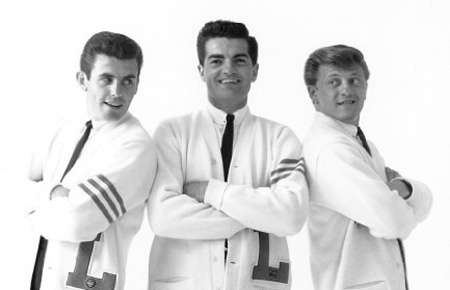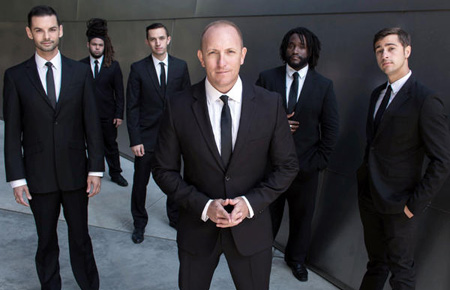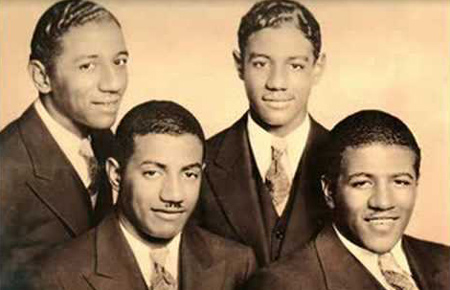In Celebration of the Human Voice - The Essential Musical Instrument
Home | Doo Wop | Barbershop | World | Contemporary | Christian | Vocal Jazz | Choral | Christmas | Instructional | Arrangements
Classical | Opera | Musicals | Personality | Young Singers | Disney | Videos | Songs | The Artists

Groups:- All | Vintage Harmony Groups | World Groups | Gospel Groups | Vocal Jazz Groups
Female Contemporary | Mixed Voice Contemporary | Male Contemporay | Contemporary Christian
Male Choral | Female Choirs | Mixed Voice Choirs | Early Music
Boyschoirs | Girl Choirs | Mixed Voice Childrens Choirs
Male Vocal Jazz Groups
Displaying 1 - 16 of 16 items.
Ames Brothers
Sons of Russian Jewish immigrants from the Ukraine, the Ames Brothers were among the top selling artists of the early 1950s. Their close-harmony style had few equals, producing a chain of Top Ten hits throughout the decade. Born into a large family (five brothers and four sisters in all), the siblings were taught a love for music at an early age. Though they won several amateur singing contests during their youth they didn't turn professional until after they had finished school. All four were good students and athletes and initially chose to pursue careers other than pop stardom. Gene became a painter and a semi-pro baseball player. Vic was an actor and professional boxer. Eddie became a table tennis champ. And Joe won a full engineering scholarship to UCLA. He left after only a year, however, transferring back home to Boston College to study music. His studies eventually earned him a starring role in the Montreal Metropolitan Opera.
Bobby McFerrin
On the 11th of March, 1950, Bobby McFerrin was born. His parents were classical singers and he began to study music theory early on in his life. His family then moved to Los Angeles. During high school and then in College, UCSC, he focused on the piano. Once he finished college, Bobby McFerrin toured with numerous bands including the Ice Follies.
However, it was only in 1977 that Bobby McFerrin decide to become a singer. At one point he met Bill Cosby who arranged for him take part in the 1980 Playboy Jazz Festival. It was only two years later where he released his firm album called "Bobby McFerrin" in 1982. It was in 1983, that Bobby McFerrin started converting without a band. This eventually led him to make a solo tour in Germany. It was in Germany that he recorded his album "The Voice". From that point on, he continued to make solo tours in the most prestigious locations. It is also important to realize that Bobby McFerrin worked with several important people like Garrison Keillor, Jack Nicholson, and Joe Zawinul. On "Another Night in Tunisia", Bobby McFerrin won two Grammies.
Comedian Harmonists
In some ways Comedian Harmonists might be called the first German boy group. Inspired by the American group 'The Revelers', Harry Frommermann published an ad in a local newspaper, auditioned and finally founded an ensemble consisting of 3 tenors, a baritone, a bass and a pianist.
After considerable training they met with initial success and rose to immense popularity. Sold out shows, records and movie appearances crowned their success.
However, the advent of Hitler's regime smashed their plans, as three group members were Jewish. They split and both parts tried to repeat the success with replacements - the Jewish members in the United States and the other three in Germany. Neither of them succeeded.
Four Aces
One of the most successful pre-rock vocal groups, the Four Aces did well during the early '50s with a narrow range of pop material but burned out before decade's end. Founded by Navy shipmates Al Alberts and Dave Mahoney, the act added Lou Silvestri and Sol Vaccaro before making a name for themselves around their native Philadelphia. After failing to find a distributor for their debut single "(It's No) Sin," Alberts founded his own Victoria label to release the single. It became a big hit in late 1951 and sold a million copies. Signed to Decca before the end of the year, their debut single for the label, "Tell Me Why," just barely missed the top of the charts and sold a million copies as well. A few Top Ten hits followed during the early '50s before the theme to Three Coins in the Fountain hit number one in 1954. Another movie theme, "Love Is a Many-Splendored Thing," spent over a month at the top during 1955.
Four Coins
Formed in Canonsburg, Pennsylvania, USA, in 1952, the vocal harmony group the Four Coins consisted of George Mantalis, James Gregorakis and brothers George and Michael Mahramas. Originally the quartet were horn players in an orchestra with Bobby Vinton, who was an unknown at the time. At the end of 1952 the foursome began harmonizing together, and in January 1953 appeared on an 'amateur hour' radio programme, which they won. They left Vinton in 1953 and began a residency at a Pittsburgh club called the Blue Ridge Inn, naming themselves the Four Keys.
They recorded their first singles in November 1953 for Corona Records, which led to a contract with Epic Records, a branch of the larger Columbia Records. Taking their cue from another quartet, the Four Aces, the group changed its name to the Four Coins. The group's first Epic single, 'We'll Be Married (In The Church In The Wildwood)', sold well but it was not until 1957 that they recorded their biggest hit, 'Shangri-La', which reached number 11 in the US charts and earned a gold record. The group had charted seven times by 1959. In 1960 they changed labels to MGM Records and continued to record for Jubilee Records, Vee Jay Records and Roulette Records, undergoing personnel changes along the way. They disbanded in 1970.
Four Freshmen
The Four Freshmen were one of the top vocal groups of the 1950s, and formed the bridge between '40s ensembles like Mel-Tones and harmony-based rock & roll bands such as the Beach Boys as well as groups like Spanky & Our Gang and the Manhattan Transfer. The group's roots go back to the end of the 1940s and a barbershop quartet-influenced outfit called Hal's Harmonizers, organized at the Arthur Jordan Conservatory of Butler University in Indiana by two brothers, Ross and Don Barbour. Their repertoire centered on standards such as "Moonglow" and "The Christmas Song," and they began to show an unusually free, improvisational approach to their harmony singing. A couple of membership changes brought Bob Flanigan, a cousin, into the fold alongside Hal Kratzsch, and suddenly the Four Freshmen were assembled in all but name, and that fell into place a little later.
Four Lads
From college campuses to supper clubs, fairs to industrial shows, commercials to concert halls, Tokyo's Latin Quarter to New York's Copacabana, Glasgow's Empress Theatre to Notre Dame, Las Vegas' Sands Hotel to Honolulu Stadium, Okinawa's Naha Theatre to Manilla's Aranete Concert Hall... the Four Lads radio, television and live appearances reads like a veritable "who's who" of the entertainment industry. The Lads launched their professional career in 1950 singing in local clubs around Toronto. Quite a few "Ups and Downs" later, the boys had a chance for a tryout performance at New York's posh dinner club, Le Ruban Bleu. There, Mitch Miller saw them and put them on the million-selling Johnnie Ray records "Cry" and "The Little White Cloud That Cried". After that, the Lads were signed to their own recording contract, receiving their first Gold Record in 1953 for "Istanbul". Their success story includes the sale of some 50 million singles and albums to date.
Four Preps
The clean-cut West Coast-based Four Preps are best remembered for a string of Top 100 hits during the late '50s and early '60s, including "Twenty Six Miles (Santa Catalina)," "Big Man," "Down by the Station," "Lazy Summer Night," "Got a Girl," "It Ain't Never," "Moon River," "Lollipops and Roses," "My Special Angel," and others. Ultimately, the Four Preps' biggest influence can be heard via their impact on Brian Wilson, whose harmony-driven production for the Beach Boys was a direct antecedent of the Four Preps' sound.
Four Tunes
The Four Tunes, like many African-American groups of the 40s and early 50s, were a pop rather than a R&B ensemble. The group had its origin in the Brown Dots, and was formed by Ivory 'Deek' Watson (18 July 1909, Mounds, Illinois, USA, d. 4 November 1969, Washington, DC, USA) after he first fell out with the rest of the Ink Spots in November 1944. The other members of the original Brown Dots line-up were Pat Best (b. William Best, 6 June 1923, Wilmington, North Carolina, USA, d. 14 October 2004, Roseville, California, USA; baritone), Jimmy Gordon (bass) and Joe King (first tenor), although the latter was quickly replaced by Jimmy Nabbie (b. USA, d. September 1992). While still with the Brown Dots, Best, Gordon and Nabbie left Watson and joined with second tenor Danny Owens in 1946 to record on the Manor label as the Sentimentalists, changing their name shortly afterwards to the Four Tunes.
Hi-Lo's
One of the most innovative jazz/pop vocal groups of all time, the pioneering Hi-Lo's influenced countless pop, R&B, and doo wop groups from the '50s right up to the present.
They formed in December 1953 when Gene Puerling of Milwaukee and friend Bob Strasen met Clark Burroughs and Bob Morse. The latter two were vocalists with the Encores, the vocal group for the Billy May Band. When Billy's band stopped traveling, the Hi-Lo's were born. Reportedly named because of their extreme vocal and physical ranges (Strasen and Morse were tall, Gene and Clark were short), the Hi-Lo's practiced at Clark and Gene's Los Angeles apartment, refining their revolutionary voicings. The group were themselves influenced by such artists as The Four Freshmen, The Modernaires, and Mel Torme's Mel-Tones.
Hudson Shad
When Hudson Shad gave their German debut in the summer of 1995 they were hailed as the first equal heirs to the Comedian Harmonists by national news magazine Der Stern. This statement has since been repeated many times by the German media - TV, radio and print, both national and local. During three tours and several guest performances Hudson Shad has been welcomed with an enthusiasm as if the prodigal sons had come home. They have sold out prestigious houses like the Theater des Westens in Berlin, the Prinzregenten Theater in Munich and Gewandhaus in Leipzig. On a different occasion in Munich their shows had to be transferred from the medium-sized Lustspiel-haus to the larger Zirkus Krone. What sets Hudson Shad apart from other groups of their genre is first of all their musical professionalism.
Just 4 Kicks
Four uniquely talented and musically successful vocalists from the West Coast, each with independent careers in the music industry, were thrust together at several Northwest jazz festivals in 1993, and a quartet emerged! Just 4 Kicks' Kirby Shaw, from Ashland, Oregon, is one of the most well-known choral and vocal jazz composers/arrangers of our time. Randy Crenshaw is among the first-call studio singers and arrangers in Los Angeles. Four Freshmen alumnus Kirk Marcy directs the internationally-acclaimed vocal jazz ensemble Soundsation at Edmonds Community College, just north of Seattle. Vijay Singh, widely known for his versatility as a composer, arranger, soloist, and director of the vocal jazz program at Central Washington University in Ellensburg, Washington, rounds out the quartet.
Kirby Stone Four
The Kirby Stone Four were one of those ubiquitous white vocal ensembles that seemed to pop up everywhere in the 1950s, drawing on several musical genres and melding them into an attractive pop sound -- they displayed a harder, more complex, and occasionally provocative edge than most of their rivals, which, along with their selection of repertoire, helped distinguish them from the pack. Though never as conspicuously successful as, say, the Four Freshmen, the Kirby Stone Four generated a series of singles and a small number of albums that evoke their era about as well as those of the Four Freshmen, the Lettermen, et al., with a very upbeat, swinging sound not too far removed from the music that Frank Sinatra was making around the same time -- though Sinatra would probably never have stood still for the occasional novelty-type tunes that they recorded.
Lettermen
The most famous line-up of this very successful US close-harmony pop trio comprised Tony Butala (20 November 1940, Sharon, Pennsylvania, USA), Bob Engemann (b. 19 February 1936, Highland Park, Michigan, USA), and Jim Pike (b. 6 November 1938, St. Louis, Missouri, USA). Pike, a letterman at Utah's Brigham Young University, released an unsuccessful single on Warner Brothers Records in 1959. In 1960, he and fellow student and ex-Mormon missionary Engemann formed a trio with Los Angeles-based supper-club singer Butala, who had recorded previously on Topic and Lute and had been using the Lettermen name since 1958.
m-pact
Hailed "one of the best pop-jazz vocal groups in the world" by the San Francisco Chronicle, m-pact is respected worldwide as a cutting edge trailblazer in the realm of vocal music. Emerging from an age of auto-tune and overproduction, this Los Angeles-based ensemble has cultivated a new generation of ears hungry for the fresh, raw power of nature's "first instrument" - the human voice. Their sophisticated sound & accessible appeal have garnered vast accolades, from Vocal Group of the Year (the LA Music Awards), an Indie nomination (the Independent Grammy), & Artist of the Year (Seattle Music Awards), to Grand National Champs of the Harmony Sweepstakes competition.
Mills Brothers
The brothers were highly successful and well liked. They were recognized nationally, then internationally. In 1934, The Mills Brothers became the first African-Americans to give a command performance before British royalty. They performed at the Regal Theatre for a special audience; King George V, Queen Mary, and the very special woman sitting in a box seat, their mother. Soon after this, while performing in England, John Jr. became ill. He was months recovering from pneumonia. Before he was completely well, the Brothers returned to England. John Jr. once again became sick, then died in the beginning of 1936.
After signing the three-year contract with William S. Paley, they became a national sensation. Their first record recorded for Brunswick, a remake of their "Tiger Rag" became a nation wide seller, the only record at that time to sell more than a million copies. Other hits quickly followed -- "Goodbye blues", their theme song, "You're Nobody's Sweetheart Now," "Ole Rockin' Chair," "Lazy River", "How'm I doin'," and others.
Select a Category |
Want to Sing? - Find a Chorus Near You
List of Choruses by State | List of Choruses by City

